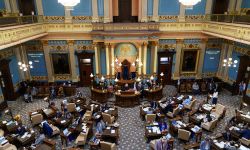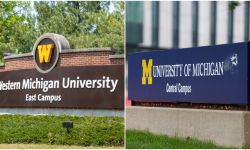Federal COVID funding varies 100-fold across Michigan schools

Some Michigan school leaders are happier than others about federal COVID relief funding.
In some cases, 100 times happier.
A Bridge Michigan analysis found funds received and expected to be received by Michigan school districts in federal COVID relief can vary by more than 100-fold on a per-student basis.
Cumulative federal aid allocated to Michigan districts in two stimulus packages passed by Congress in 2020, totaling more than $1.8 billion, averages $1,272 per student. But Bridge’s analysis found the per-pupil amounts ranged wildly, from $13,232 per student in Flint City School District to $69 per student in Northville Public Schools in Wayne County. That’s a 19-fold difference.
There are 189 school districts and charter schools receiving federal relief funds equivalent to more than $2,000 per student, and 41 getting less than $200 per student.
The reason: School COVID relief funding that passed Congress in 2020 was tied to Title I guidelines, which provides funds to help low-income students.
Even though learning loss is expected to be greater among low-income students, some Michigan school leaders are grumbling about disparities in federal COVID relief, arguing that affluent schools faced some of the same costs associated with the pandemic as districts in poor communities.
“A spread that is 100 times larger per pupil is … unusual,” said Daniel Behm, superintendent of Forest Hills Public Schools, an affluent district near Grand Rapids, which is receiving $91 per student. “It’s something that I’ve never seen before.”
Michigan school districts, both rich and poor, have hemorrhaged cash for pandemic precautions such as personal protective equipment, extra cleaning and updated ventilation systems. Many districts also have experienced enrollment declines this year, which lowers the money they receive from the state at a time costs have risen.
The cumulative $1.8 billion allocated to Michigan schools from the CARES Act in spring 2020 and a second stimulus package passed by the Congress in December are desperately needed to balance district budgets and gear up for what is expected to be a Herculean effort to help students recover from pandemic learning losses.
The funding allocations are meant to provide the most money to low-income students, who studies suggest are the most likely to have lost academic ground during the pandemic.
Research by McKinsey & Co., a global management and consulting firm, estimated that intermittent school closures in the United States in the 2020-21 school year may result in some low-income students falling behind by more than a year compared to where they would have been in a normal classroom setting.
That same study estimated Black students will fall behind by an average of 10.3 months, Latino students by 9.2 months, and white students by six months.
Schools already have money from the CARES Act. Funds from the second federal stimulus package – four times larger than CARES Act school funding – must be approved for distribution by the Legislature and Gov. Gretchen Whitmer, but state leaders have no control over how most of the money is allocated. The funding formula was set by Congress.
On Tuesday, Whitmer announced that the 10 percent of federal school relief dollars the state can control, along with $300 million of state funds, will be split among schools on a per-pupil basis, and on the percentage of students with special education designations.
Whitmer and the Legislature have no control over the other 90 percent of federal funding which must be distributed based on formulas in Title I – federal guidelines that typically direct money to disadvantaged students, and that also tends to favor large school districts.
Detroit Public Schools Community District, the state’s largest district, received 30 percent of school relief funds distributed through Title I guidelines, while its enrollment is 3.5 percent of the state total.
The $8,779 Detroit received and scheduled to receive in federal aid is more than the $8,142 per student the district received from the state in per-pupil funding for the 2020-21 school year.
Meanwhile, Novi Community Schools, in the Detroit suburbs, is getting $81 per student in federal help.
Detroit Superintendent Nikolai Vitti said the funding distribution is justified because "anything negative that affects the nation or the state hits Detroit 100 fold" — and state funding of schools is otherwise inequitable.
David Arsen, professor of education at Michigan State University, said Congress used Title I as a funding guideline for school funds because it was a quick way to get money to states.
“The [Title I] guidelines are already there,” Arsen said. “To come up with a new funding formula, in the context of many other negotiations taking place [in the stimulus packages,] would have taken time. Title I was matter of convenience while broadly aligned with the notions of need.
“But those notions of need are not calibrated to the needs that arise from a pandemic,” Arsen said.
The result is COVID relief funding that is vastly different between neighboring school districts.
For example, Godfrey-Lee Public Schools in Grand Rapids will get an infusion of cash equivalent to about $1,413 per student. That’s half the amount per student that neighboring Grand Rapids Public Schools ($2,881 per student), but 15 times more than nearby Forest Hills Public schools ($91 per student).
Godfrey-Lee Superintendent Kevin Polston said he’s “happy for [lower-income] districts getting those funds. It’s rare in our country’s education where we’ve looked at the [economic makeup of] student population when considering funding.”
Still, Polston said the federal COVID funding is out of whack.
“I’d like to see some balance” in fund allocation, Polston said. “There needs to be recognition that all districts have some costs that are new this year, like PPE [personal protective equipment,] cleaning, substitute teaching, online learning costs.”
The relief packages have put many school leaders in an uncomfortable position of pushing back against equitable funding — allocating money to schools based on the needs of students, rather than across-the-board, per-pupil funding.
In recent years, state studies and school reformers have advocated for the state to adjust its school funding formula, which is based primarily on student head-count. In its stead, they would like to see more funds go to low-income schools, where students often require more support to achieve at the same level as their more affluent peers.
The pandemic, though, is something that has hurt students in every community, said Tina Kerr, executive director of the Michigan Association of Superintendents and Administrators.
“We recognize the needs of our most vulnerable students,” Kerr said. “But it doesn’t matter what district you’re in, you still have costs because of COVID.”
State Superintendent Michael Rice agreed. “Educators across the country appreciate enormously the infusion of additional federal dollars that are badly needed and greatly appreciated,” Rice said. “That said, the federal Title I Part A formula is an awkward vehicle for distributing relief during a pandemic and must be re-thought if additional federal dollars are made available. That formula, while perhaps legitimate for distributing funds to support educationally disadvantaged students under normal circumstances, is inadequate to support all children during a pandemic.”
Newly elected President Joe Biden has proposed a third COVID relief package that would provide an additional $130 billion to the nation’s K-12 schools, with some $3 billion to $4 billion coming to Michigan schools.
Michigan school leaders are pushing for any new school COVID relief funding to not be tied to the Title 1 formula.
“It would be helpful to understand certain items, whether it’s PPE or ventilation systems or other mitigation strategies, those costs are more universal than what this very large variance (in funding) would indicate,” said Forest Hills’ Behm.
Added State Superintendent Rice, “future education pandemic relief funds must be distributed through a new formula that addresses two distinct features: the baseline needs of all children in and after a pandemic and the greater needs of certain groups of children in and after the pandemic.”
Michigan Education Watch
Michigan Education Watch is made possible by generous financial support from:
Subscribe to Michigan Education Watch
See what new members are saying about why they donated to Bridge Michigan:
- “In order for this information to be accurate and unbiased it must be underwritten by its readers, not by special interests.” - Larry S.
- “Not many other media sources report on the topics Bridge does.” - Susan B.
- “Your journalism is outstanding and rare these days.” - Mark S.
If you want to ensure the future of nonpartisan, nonprofit Michigan journalism, please become a member today. You, too, will be asked why you donated and maybe we'll feature your quote next time!






